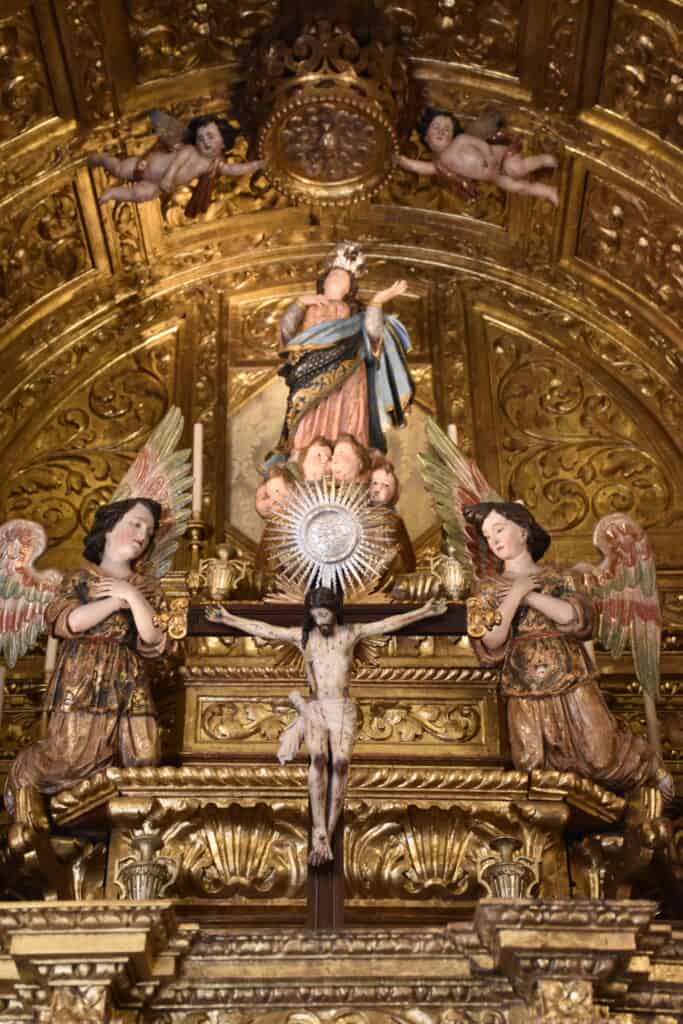Versão portuguesa aqui.
GPS 38.69519015942945, -9.421133373353912
The Igreja Matriz de Nossa Senhora da Assunção is considered the most emblematic church in the village of Cascais. Its original construction dates back to at least the 16th century. XVI, as it is represented in an engraving edited in 1572 inserted in the work “Civitates Orbis Terrarum” by Georg Braun and Frans Hogenberg, which represents the town and coast of Cascais in around 1530.

The Church has a longitudinal plan, with the facade facing west. It comprises 3 bodies separated by stonework pilasters and two side bell towers, with a square section. On the Gospel side, there is a marble pulpit from the 17th century.
The altarpiece of the Church, in gilded carving, forms an arch that forms a frame for a throne, where today there is an image of Our Lady of the Assumption being crowned by two angels from heaven. Below the throne is a tabernacle, accompanied by two guardian angels who watch over him, as tradition has it.

Placed along its nave, the Church has a set of important works of ancient painting: four works by the Master of Lourinhã, representing the Virgin of the Annunciation and the Angel Gabriel, the Nativity and the Adoration of the Magi, dating from around 1520 -25, and eight paintings by Josefa de Óbidos: Sagrada Família (1672), the series of five paintings about Saint Teresa of Jesus or Ávila, also dated 1672: Saint Teresa before the Holy Trinity, The Virgin and St. José give a necklace to Saint Teresa, Saint Teresa mystical wife, Transverberation of Saint Teresa and Saint Teresa inspired by the Holy Spirit, to which are added the Baby Jesus Savior of the World (1673) and the Vision of St. John of the Cross (c. 1673), all of them designed for the Convento da Piedade (current Cascais Cultural Center) from where they were transferred after its extinction. On the ceiling, we find a central medallion with a painting representing the Assumption of Our Lady by the painter José Malhoa, dated 1900.
Tilework and sacristy
In the chapel of the Blessed Sacrament, we find a Last Supper painted by Pedro Alexandrino de Carvalho and, closing the same chapel, a carved wooden gate-grill which, according to tradition, is the work of an author from the village.

In terms of tiles, the Church is extremely rich in terms of biblical scenes illustrating sacred history. Along the nave there are various episodes from the life of Our Lady and, on the wall next to the Gospel right at the entrance, there is a curious representation of an excerpt from the Book of the Apocalypse. On the wall opposite this panel, a more recent panel, dating from 1908 and by Pereira Cão.

In the sacristy, there are interesting tile panels representing themes from the Old Testament. The inscription present there testifies that they were placed there at the behest of the fishermen of the village, by the so-called Brotherhood of the Seafarers, in the year 1720.
Over the years the Church has undergone several renovation works. The most recent took place in the 21st century in the years 2010-11 and involved the entire area of the presbytery, the altar and the ambo, as well as the area of the high choir and the pews of the Church, in addition to the restoration of the sacristies.
